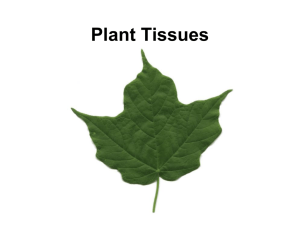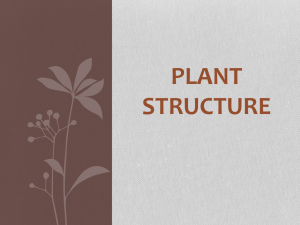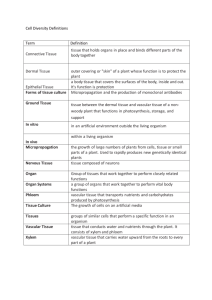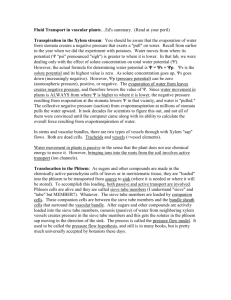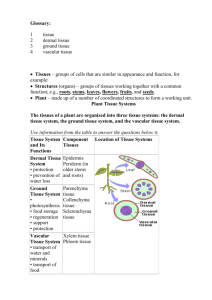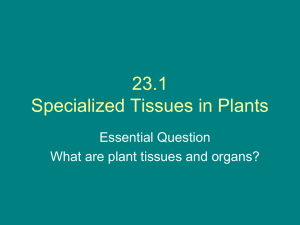File
advertisement
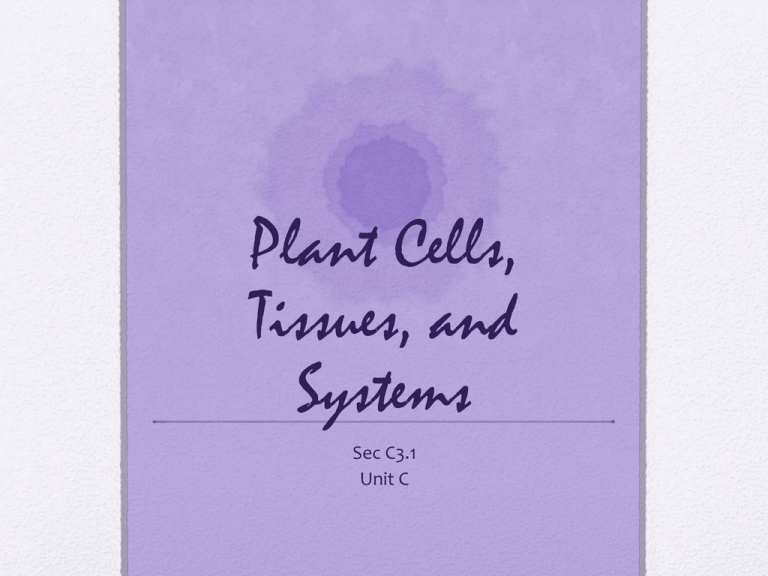
Plant Cells, Tissues, and Systems Sec C3.1 Unit C Objectives • describe the specialized structures and functions of cells in the leaf system • explain the transport system in plants • relate a multi-cellular level of organization with cell, tissue, and system specialization Multicellular vs Unicellular • What are the advantages to having a large structure with lots of cells? • Division of Labour • When a cell is specialized (performs a particular function), it is more effective and efficient. • A single-celled organism must multi-task (do many jobs). Multicellular vs Unicellular • Size • The surface area to volume ratio and related rate of diffusion restricts growth in unicellular organisms. • Efficient transport systems within multicellular organisms allow for growth. Multicellular vs Unicellular • Interdependence of Cells • A single-celled organism is dependent on that one cell. • If a multicellular organism loses a cell, the entire organism will not die. However, a cell not functioning properly (ex. cancerous) can cause problems for the rest of the organism. Plant Structure • Plants are multicellular: made of many parts, each with its own function – organized in increasing complex levels of organization • Tissues= group of cells performing same function together • Organs= tissues contributing to same function • System= group of interconnected organs (two in plants) • Shoot system everything above ground • Root system everything below ground and aerial roots What about animals? • What are some examples of tissues, organs and systems in humans? • Ex. Heart/cardiac tissue heart circulatory system Do now • Find the definition/function associated with each of the following terms (workbook - chart) Meristem Dermal tissue/epidermis Cuticle Ground tissue Vascular tissue Xylem tissue Phloem tissue Sieve tube cells Companion cells How did you do? • Meristem- growth areas • Dermal tissue/epidermis- outer layer of cells; responsible for exchange of matter and gases and protection • Cuticle- waxy substance; resists attack and prevents water loss • Ground tissue- majority of plant; strength and support (stem); food and water storage (roots); site of photosynthesis (leaves) How did you do? • Vascular tissue- transport of materials; xylem and phloem • Xylem- moves water and minerals from roots to leaves; thick, non-living, perforated cells • Phloem- transports sucrose and other sugars from leaves to other parts; made of sieve cells • Sieve tube cells- form continuous ducts; perforated • Companion cells- direct activity of sieve tube cells Plant Growth • Cells divide to grow and repair damage. This cell division is called mitosis. • In plants, increase in size results from the cell division in growth areas called meristems Rapidly dividing cells - Cell walls thin, nuclei are large, vacuoles, small or absent Meristems • Onion root tip – note different stages of mitosis (cell division) Specialization of Cells • Once cells are no longer in the meristem, they will specialize • Produce products only for their function • The root and shoot systems are made up of 3 types of tissues: • Dermal Tissue (epidermis) • Ground Tissue • Vascular Tissue Types of Tissue • Dermal Tissue • Outer layer of cells that covers all herbaceous (non-woody) plants. • Responsible for exchange of matter and gases into and out of the plant. • Also protects the plant from disease. This is done by the cuticle (waxy substance), which resists attacks from micro-organisms and helps reduce water loss. Types of Tissue • Ground Tissue • Found underneath epidermis, it makes up majority of plant. • Provides strength and support to the plant (stem). • Involved in food and water storage (roots). • Location of photosynthesis (leaves). Types of Tissue • Vascular Tissue • Responsible for transport of material, which occurs in xylem tissue and phloem tissue Vascular Tissue - xylem • Cells in xylem tissue allow transport of water • Die when differentiate leaving empty tubes Long fibres in celery are vascular tissue (both xylem and phloem) Vascular Tissue - phloem • Phloem Tissue • Formed from long sieve tube cells (no nuclei), which are connected with companion cells (nucleated) that direct activity. • Transports carbohydrates and water from the leaves to other parts of the plant. Leaf Cross section http://dendro.cnre.vt.edu/forestbiology/photosynthesis.swf Vascular Tissue Vascular tissue From: http://www.youtube.com/watch?v=4V0VcNCRKTo&feature=related at 4:14 Vascular Bundles Sieve tubes More specialization: Roots • Cells in root system will produce tiny hair-like projections called root hairs • Why is this beneficial for the plant? • Increases the surface area for absorption of water Root hairs Root hairs More … • Dermal cells in shoot system produce a cuticle • Why is this beneficial? • Prevents water loss And last… • Lower epidermis in leaves have guard cells • Form tiny pores called stomata for gas exchange • Only cells with chloroplasts • Why is this important? • Photosynthesis! Leaf Cross section http://dendro.cnre.vt.edu/forestbiology/photosynthesis.swf Leaf Cross section • Can you indentify some of the structures? How does water move up the plant? • Gravity should pull water down – how does it move up from the roots to the leaves? How do all these specializations allow for this? Shall be investigating this in this section. • http://www.youtube.com/watch?v=U4rzLhz4HHk&fea ture=related
